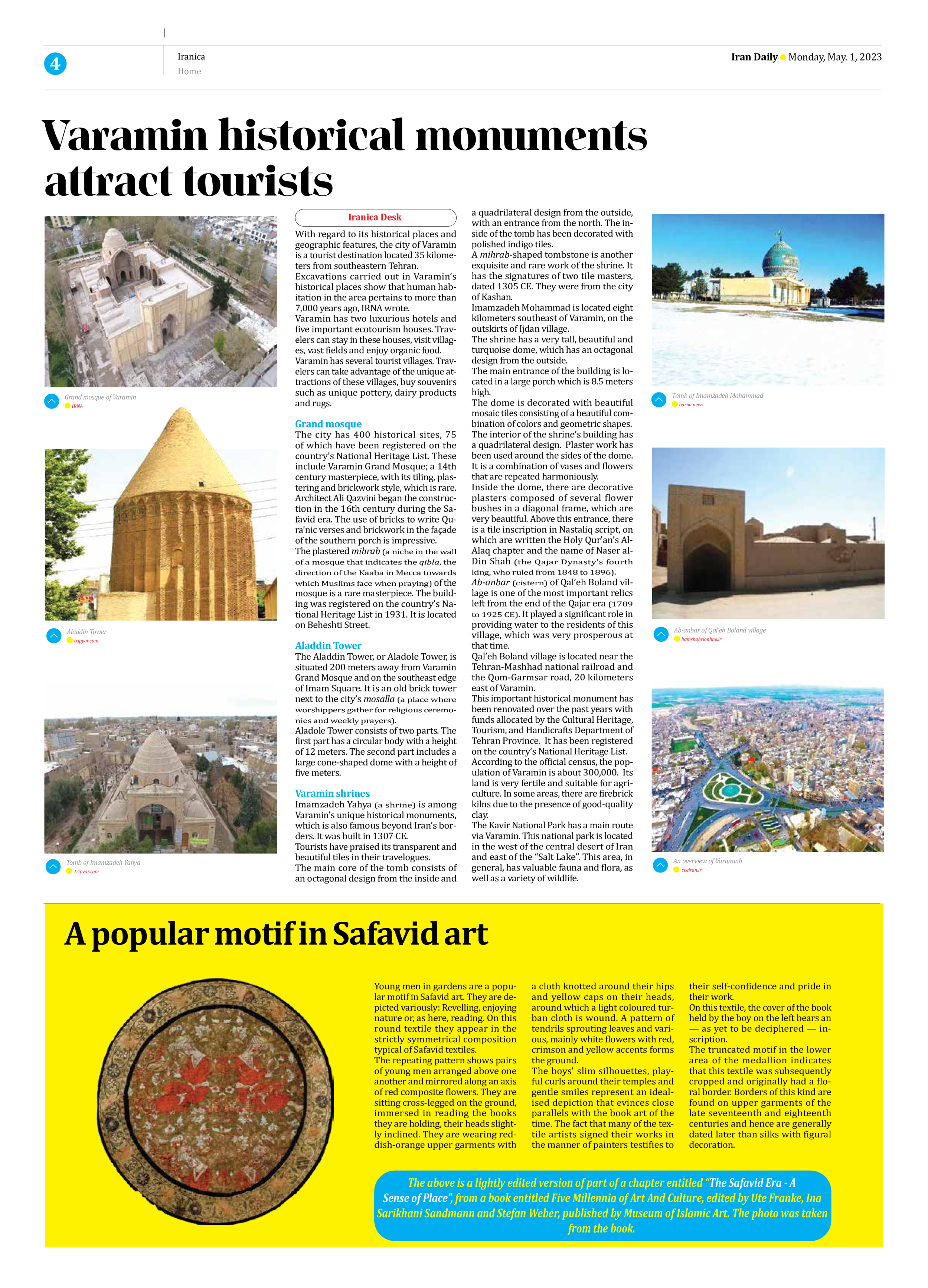
Varamin historical monuments attract tourists
With regard to its historical places and geographic features, the city of Varamin is a tourist destination located 35 kilometers from southeastern Tehran.
Excavations carried out in Varamin’s historical places show that human habitation in the area pertains to more than 7,000 years ago, IRNA wrote.
Varamin has two luxurious hotels and five important ecotourism houses. Travelers can stay in these houses, visit villages, vast fields and enjoy organic food.
Varamin has several tourist villages. Travelers can take advantage of the unique attractions of these villages, buy souvenirs such as unique pottery, dairy products and rugs.
Grand mosque
The city has 400 historical sites, 75 of which have been registered on the country’s National Heritage List. These include Varamin Grand Mosque; a 14th century masterpiece, with its tiling, plastering and brickwork style, which is rare.
Architect Ali Qazvini began the construction in the 16th century during the Safavid era. The use of bricks to write Qura’nic verses and brickwork in the façade of the southern porch is impressive.
The plastered mihrab (a niche in the wall of a mosque that indicates the qibla, the direction of the Kaaba in Mecca towards which Muslims face when praying) of the mosque is a rare masterpiece. The building was registered on the country’s National Heritage List in 1931. It is located on Beheshti Street.
Aladdin Tower
The Aladdin Tower, or Aladole Tower, is situated 200 meters away from Varamin Grand Mosque and on the southeast edge of Imam Square. It is an old brick tower next to the city’s mosalla (a place where worshippers gather for religious ceremonies and weekly prayers).
Aladole Tower consists of two parts. The first part has a circular body with a height of 12 meters. The second part includes a large cone-shaped dome with a height of five meters.
Varamin shrines
Imamzadeh Yahya (a shrine) is among Varamin’s unique historical monuments, which is also famous beyond Iran’s borders. It was built in 1307 CE.
Tourists have praised its transparent and beautiful tiles in their travelogues.
The main core of the tomb consists of an octagonal design from the inside and a quadrilateral design from the outside, with an entrance from the north. The inside of the tomb has been decorated with polished indigo tiles.
A mihrab-shaped tombstone is another exquisite and rare work of the shrine. It has the signatures of two tile masters, dated 1305 CE. They were from the city of Kashan.
Imamzadeh Mohammad is located eight kilometers southeast of Varamin, on the outskirts of Ijdan village.
The shrine has a very tall, beautiful and turquoise dome, which has an octagonal design from the outside.
The main entrance of the building is located in a large porch which is 8.5 meters high.
The dome is decorated with beautiful mosaic tiles consisting of a beautiful combination of colors and geometric shapes.
The interior of the shrine’s building has a quadrilateral design. Plaster work has been used around the sides of the dome. It is a combination of vases and flowers that are repeated harmoniously.
Inside the dome, there are decorative plasters composed of several flower bushes in a diagonal frame, which are very beautiful. Above this entrance, there is a tile inscription in Nastaliq script, on which are written the Holy Qur’an’s Al-Alaq chapter and the name of Naser al-Din Shah (the Qajar Dynasty’s fourth king, who ruled from 1848 to 1896).
Ab-anbar (cistern) of Qal’eh Boland village is one of the most important relics left from the end of the Qajar era (1789 to 1925 CE). It played a significant role in providing water to the residents of this village, which was very prosperous at that time.
Qal’eh Boland village is located near the Tehran-Mashhad national railroad and the Qom-Garmsar road, 20 kilometers east of Varamin.
This important historical monument has been renovated over the past years with funds allocated by the Cultural Heritage, Tourism, and Handicrafts Department of Tehran Province. It has been registered on the country’s National Heritage List.
According to the official census, the population of Varamin is about 300,000. Its land is very fertile and suitable for agriculture. In some areas, there are firebrick kilns due to the presence of good-quality clay.
The Kavir National Park has a main route via Varamin. This national park is located in the west of the central desert of Iran and east of the “Salt Lake”. This area, in general, has valuable fauna and flora, as well as a variety of wildlife.







